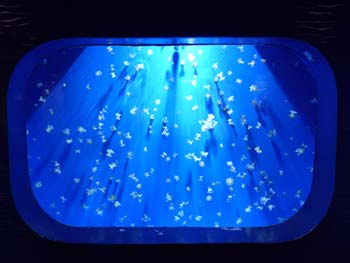Genoa (Genova in Italian) is a great destination for a city break, whether you want family fun or a cultural holiday. On this page is a run-down of Genoa’s best tourist attractions. It’s not exhaustive – there’s lots more to do around the town – but it gives an idea of the city’s wide-ranging appeal. I found Thomas Cook’s Genoa (CitySpots) a small and handy companion on a weekend break, but Genoa’s tourist information offices supply good booklets in English too. For up-to-date details on each attraction, including opening times, prices and location maps, use the right-hand-side links panel to visit their official websites.
For more general advice on Genoa, including combined museum tickets, public transport information and restaurant recommendations, see my Introduction to Genoa.
Find and book hotels in Genoa. With location maps and guest reviews.
Waterfront – Porto Antico
Down by the rejuvenated Porto Antico (Old Port) are a number of attractions for all the family, including the Aquarium, which, along with the UNESCO listing, is Genoa’s proudest attraction, and where visitors can admire sharks and dolphins up close. Nearby is the Bigo, a panoramic lift on a crane, designed by local star architect Renzo Piano. Most of the newer attractions here are expensive, but you can buy combined ‘Acquario Village’ tickets; expensive but worth doing if you want to visit several sights. The ticket also offers discounts in shops and cafes and a free ride on a mini-train which links the Aquarium-operated attractions. There’s a useful tourist information kiosk by the Porto Antico where you can pick up information and book guided tours of the city centre; this is a good way of getting to know Genoa.
Aquarium
The Genoa aquarium (Acquario) is renowned throughout Italy and the town is very proud of the establishment, which is the largest in Europe. It is a genuinely interesting attraction to visit with fascinating living exhibits. Like most modern zoos, the aquarium has displays about endangered species and biodiversity, though this always sits rather uncomfortably with the reality of captive animals. However, if sea life is your thing (perhaps even if it isn’t) you will enjoy a visit, and children should be held spellbound by the diving dolphins, the sharks up close and the chance to touch a fish. Some of the displays – such as jellyfish – are very stylishly presented and most offer the visitor good opportunities to view animals – penguins, sharks, dolphins – from different perspectives. A little hummingbird ‘forest’ is enclosed within the aquarium (extra charge unless you’ve already got a combined ticket). The aquarium is open every single day of the year. If you still haven’t had enough wildlife, you can continue to the neighbouring Biosfera, a biosphere with a warm humid climate, jungle vegetation and more birds. This is only a small attraction, but I was charmed by the friendly parrot perched on the ticket-assistant’s shoulder.
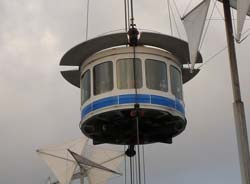
Bigo
The Bigo is a panoramic lift (elevator) by the old harbour which offers views over Genoa and its waterfront. The lift was designed by Renzo Piano and modelled on a ship’s crane. It’s a striking touch of modernism and a good novelty activity, offering unaccustomed views of the city. There’s an Italian commentary; and the circular glass-sided lift revolves to give everyone a full 360-degree panorama of Genoa. The Bigo doesn’t operate every day in winter. The long extending arms of the Bigo structure also reach out to a covered pavilion area where there is a skating rink in winter and other events throughout the year.
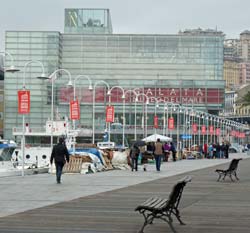
Galata Museo del Mare
Galata ‘Museum of the Sea’ is a large maritime museum by the docks. It is a modern and really excellent museum and well worth visiting if you have time. The long circuit around ascending floors of the museum covers Genoa’s maritime history, illustrated with period paintings of the busy dock developments, recreations of ships, historical exhibits and interactive installations. It is mostly geared for visiting Italians, but there are some English translations and it is easy to get the gist of the large-scale exhibits. These are good fun for adults and children alike: you can attempt to steer a boat through storms, or clamber across a deck and peer into the captain’s cabin. The most inventive exhibition I’ve seen there was about emigration from Italy to the United States – visitors could pick up a passport, be interrogated by a videoed port official and then – best of all – explore the recreated corridors and cabins of a migrant-packed steamship. Don’t miss the museum’s wonderful panoramic rooftop terrace; a great spot for viewing the town, with guides for identifying buildings.
Boat trips
Regular ferries operate from the port to Pegli, along the coast past the airport, where you can visit museums and gardens. This boat service is part of Genoa’s public transport network. There are also pleasure boat trips from the docks, which vary according to the season and demand. All year around you are likely to find short boat tours of Genoa’s historic waterfront. In the summer there are also trips to some of Liguria’s prettiest seaside resorts, and whale-watching excursions.
More
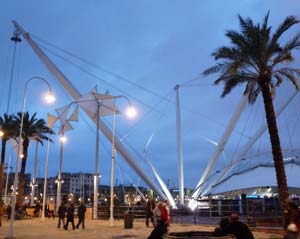 Other museums by the Porto Antico include the Città dei Bambini, a kind of advanced indoor playground with rooms for children of different ages where they can pretend to be giant ants, or experiment with cameras in a ‘news studio’. As a free alternative there’s a small children’s playground near the Bigo. There is also an Antarctic Museum, the Museo Nazionale dell’Antartide, and even a pirate galleon (constructed for the Roman Polanski film Pirates). On weekends and holidays the waterfront area is alive with visiting families and tourists. Even in November I spotted the following tours: harbour boat excursions, a horse-drawn carriage ride, two mini-trains, an open-top minibus and novel Segue tours. If you spend much time around the Porto Antico you’ll be digging deep into your pockets, but there should be enough to keep everyone entertained.
Other museums by the Porto Antico include the Città dei Bambini, a kind of advanced indoor playground with rooms for children of different ages where they can pretend to be giant ants, or experiment with cameras in a ‘news studio’. As a free alternative there’s a small children’s playground near the Bigo. There is also an Antarctic Museum, the Museo Nazionale dell’Antartide, and even a pirate galleon (constructed for the Roman Polanski film Pirates). On weekends and holidays the waterfront area is alive with visiting families and tourists. Even in November I spotted the following tours: harbour boat excursions, a horse-drawn carriage ride, two mini-trains, an open-top minibus and novel Segue tours. If you spend much time around the Porto Antico you’ll be digging deep into your pockets, but there should be enough to keep everyone entertained.
Among the modern attractions and smart redevelopments you’ll also find some surviving traditions, like fishermen selling freshly-caught fish on stalls alongside the docks. There are places to eat and drink and sit, including a stylish bar, called Oltremodo, on the static ship beyond the aquarium. As well as winter ice-skating, there is also a summer outdoor swimming pool. In fact, you could quite easily spend an entire day sightseeing in the waterfront area without even penetrating into the mazes and elegant streets of Genoa.
Old Town
Genoa’s old town is a maze of narrow lanes, called caruggi, sloping up from the waterfront. Among the crowded streets are churches, grand palaces, street-corner shrines, run-down buildings, shops, bars, Genovese fast-food counters and galleries all co-existing, very disconcertingly, with the city’s red-light district. Even in the daylight some of this area is visibly seedy, with prostitutes lurking down alleys, and although the dodginess rubs shoulders with respectable citizens and businesses, this adds an ‘edge’ to the historic centre. Most big ports have a disreputable side, but in Genoa the dodginess has been neither eradicated nor concealed from tourists; it sits right in the middle of the ‘normal’ city. This is more distasteful than dangerous, but you should carry your valuables securely. If you’re visiting this area after dark, you’ll be more comfortable if you stick to routes you already know. Hotel staff are a good source of up-to-date information on where to go – and where not to go – at night.
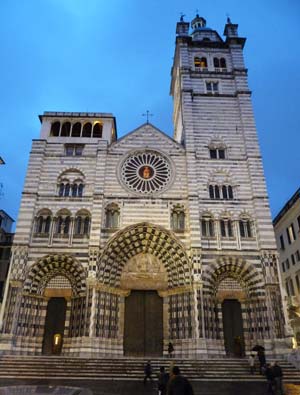
Cattedrale di San Lorenzo
The Cattedrale di San Lorenzo is Genoa’s cathedral, located in a little square uphill from the Porto Antico. The imposing building was begun in a Romanesque style and subsequently given a Gothic make-over, followed by several more centuries of restorations and alterations, and the wide range of styles on display makes it a memorable sight. The exterior is striped and ornamented with columns in many decorative coloured marbles and the steps to the church are guarded by two photogenic stone lions. Just inside the main portal is a fourteenth-century Byzantine-style fresco. The ashes of John the Baptist (source of a miraculous quantity of relics) were worshipped in the Cappella di San Giovanni Battista, a lovely Renaissance side-chapel lined with elegant statues (take coins for illumination).
St. Laurence, to whom the cathedral is dedicated, is just one of Genoa’s patron saints. Fittingly for a Republic run by bankers, Genoa maximised its chances by appointing four powerful patrons: St. Laurence, St. George, John the Baptist and St. Sebastian. St. Laurence and the grill on which he was martyred can be seen in a sculptural depiction over the main door.
Once you have viewed the cathedral you should visit its underground treasury, the Museo del Tesoro di San Lorenzo. Among the treasures on display are a bowl claimed to be the Holy Grail, a lovely Byzantine cross, a highly decorated coffer used to to carry the prized saintly ashes in procession around Genoa and a platter said to have been the one used to present John the Baptist’s head.
Galleria Nazionale di Palazzo Spinola
As you pick your way through crowds, the old centre can appear run-down and shabby, but when you lift up your eyes and look around, it’s clear that many of the buildings here are actually – or were once – very grand indeed. Palazzo Spinola is one of these elegant palazzi, right in the heart of the maze of lanes. The building dates to 1593, and passed through the hands of some of Genoa’s leading aristocratic families. Nowadays it houses an art gallery with paintings, frescoes, ceramics and furniture.
The palace is interesting for the illustration it gives into patrician life in Genoa; the opulent style of living and art-collecting of the city’s noble families. Especially on the upper floors, where there were living quarters and a kitchen (safer than the ground floor, given the risk of fire), and where you can glimpse the windows of other neighbouring buildings, you can get a sense of how the most privileged of Genoa’s population would have lived. This is given added piquancy by the gloomy alleys, bustling lanes, trading and prostitution going on nearby as it presumably has done throughout the palace’s history.
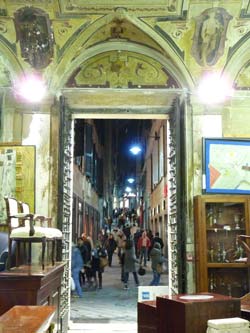
More
There are other notable churches in the historic centre. San Matteo is a pretty little church with a striped façade; San Donato is a very attractive parish church dating to the eleventh century and containing some good artworks. The Chiesa di San Siro, not far from Palazzo Spinola, is of considerable historical importance. It was Genoa’s cathedral up until the ninth century, when that role shifted to San Lorenzo, which was considered to be in a safer location. The present building dates to the 16th century, and was restored after the Second World War bombing which damaged much of the town centre. The most unusual church is San Pietro in Bianchi, in Piazza Banchi, one of the nicest little squares in the centro storico. The church is built on top of shops, and was financed by their ground rent: a novel solution befitting a mercantile city.
A good lane for an afternoon passeggiata and shopping is Via Luccoli which continues into Via Soziglia. Here you’ll find little clothes boutiques, cafes including a grand old pasticceria, posh chocolate shops and lots of homewares. For antiques, take a turn up Vico del Fieno – or for really impressive surroundings visit the Galleria Imperiale (photo, right) in Piazza Campetto, where furniture and display cases are crowded beneath Renaissance decor.
Some of the nicest places to eat and drink in Genoa are within the picturesque lanes and little squares of the historic centre, including the wine-cellar restaurant I Tre Merli and the lively ‘drinking square’ Piazza delle Erbe – see my Introduction to Genoa for recommendations.
‘New Town’
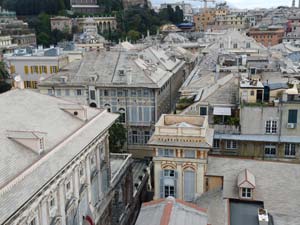
Rather confusingly, Genoa’s ‘New Town’ is no longer new at all. During the 16th and 17th centuries, town-planners built spacious elegant streets just above the crowded old town. Subsequently Genoa has expanded up the steep slopes and along the coast around the original harbour area. The 16th and 17th-century areas are a calm contrast to the narrow lanes of the old town and commerce of the Porto Antico. Via Garibaldi (originally called Strada Nuova) is the highlight of the New Town and is a sedate tourist thoroughfare. The other streets of the centre have the disadvantage of traffic but the advantages of public transport and a more familiar city centre feel, with high street shops, a theatre and museums.
Genoa’s prized UNESCO World Heritage listing is for this early example of town-planning, and for the ‘Palazzi dei Rolli’. These buildings were part of a scheme where the resident noble families, would be responsible for hosting visiting foreign dignitaries. Most of these palaces can only be viewed from the outside, though three on the narrow, palace-lined Via Garibaldi, are now art galleries.
Musei di Strada Nuova
The Aquarium is the big catch-all tourist attraction of Genoa, but the most important destination for art-lovers is the string of three palaces on Via Garibaldi grouped together as the Musei di Strada Nuova. In Italy the word palazzo is not quite equivalent to palace: it can refer to any large building. The Genoa palazzi, though, are grand enough to lay claim to the English translation.
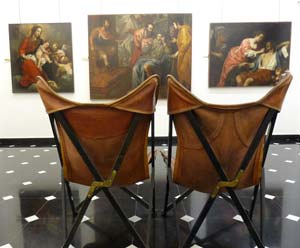
There’s a shop and ticket office on Via Garibaldi where you buy a combined ticket for the three palaces. Palazzo Rosso is the first, with a collection of art including family portraits by Van Dyck. Like many of Genoa’s historic buildings, the Palazzo Rosso was damaged by bombing in the Second World War, and rebuilt to its original plan. Don’t miss the top floor ‘flat’ (which makes you want to live there) and the lift up to a tiny roof terrace with an amazing view – and try not to be distracted by the plentiful staff, who seem bossy and very keen that visitors should follow the ‘correct’ (though not clearly indicated) route around the museums. Palazzo Bianco is a serious art gallery with some fine works including a Crucifixion by Filippino Lippi and paintings by Rubens, Caravaggio, Veronese and Ligurian artists. Visitors will find their own favourites among the excellently displayed paintings; mine were some lovely female saints by Spaniard Francisco Zurburán, who seems to have been primarily interested in the fabrics of their gowns. If you are interested in textiles, ask the way to the DVJ (Damasco Velluto Jeans) exhibition and study centre, a collection of historic fabrics. A garden terrace connects Palazzo Bianco with Palazzo Tursi, now the town hall. Here you can see Paganini’s violin ‘il Cannone’ and collections of ceramics and coins.
You’ll probably want refreshments after all the art-concentration. There’s a good choice of cafes on Via Garibaldi, some with tables outside. I ate in the Caffe dei Musei, a modern-design cafe offering cheap light lunches (I enjoyed pennette alla Norma for 4.50).
Palazzo Ducale
Just uphill from the cathedral, this monumental building was the palace of the Doge of Genoa, the city’s ruler. Nowadays it houses exhibitions and events; there is usually an interesting choice of things to see, from free photography exhibitions to major art shows. There is a Jazz Museum and even a ‘Poetry room’. If you’re looking for entertainment or just a place to get out of the rain, you’ll probably find something to look at in the Palazzo Ducale. A full list of events is published on the official website (see links panel).
One side of the palazzo opens on Piazza de Ferrari; the main, 18th-century, façade is in Piazza Matteotti, decorated by stone figures in chains which represent the vanquished opponents of mighty Genoa. The origins of the building lie back as far as the 13th and 14th centuries, but it was altered, amplified and added-to up until the twentieth century. Some of the public areas can be visited, and there are organised tours of the building’s historic tower and prisons.
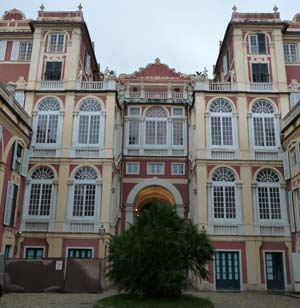
Palazzo Reale
The Palazzo Reale (‘Royal Palace’) is on Via Balbi, one of the straight palazzo-lined streets of the New Town. Running from the railway station Stazione Principe towards the heart of town, this is a useful artery for tourists. From the 1820s the Palazzo Reale was the Genoa residence of the Savoia (Savoy) dynasty, who later became the monarchs of a united Italy. The former Republic of Genoa was by then part of their kingdom.
The building’s most famous hall is the Galleria degli Specchi, the hall of mirrors; the building also contains an art collection. The palace doesn’t boast paintings quite on a par with the Strada Nuova galleries, but it’s a fairly interesting glimpse into the regal pomp and grandeur which Italy’s future royal family favoured, perhaps also providing some suggestions as to why Italy’s monarchy didn’t last.
More
Another palace to visit is the Palazzo del Principe (also called Villa del Principe), between Stazione Principe and the waterfront. The location is now overpowered by modern transport, but this was a grand residence built for Andrea Doria in around 1530, with frescoes, paintings, tapestries and a formal garden (seasonal opening). At the far side of the city centre is Genoa’s most imposing modern square, Piazza De Ferrari, by the Ducal Palace and just beyond the Old Town’s historic lanes. Commuters pile on and off buses, a giant fountain plays and residents gather to meet friends or go about their daily business. The city’s grandest theatre, the Teatro Carlo Felice is to be found here; this is the place to see opera and ballet in Genoa. Alongside the theatre is an elegant old-fashioned shopping gallery. One of Genoa’s grandest churches is also close by the piazza: the Chiesa del Gesù, decorated in Baroque style and boasting among its artworks two paintings by Rubens. Two major shopping streets branch out from the piazza; Via Roma for expensive fashions and designer names, and Via XX Settembre for a more ‘high-street’ experience.
More things to do
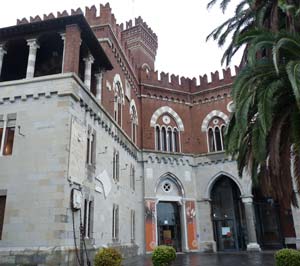
Castello D’Albertis
Castello D’Albertis is a late-19th-century residence which is a great monument to eccentricity – and also an interesting ethnographical museum. Part of the fun is getting there: you take a novel public lift which travels first horizontally then vertically to reach the heights on which the castle was built. The lift is called the Ascensore Montegalletto and departs from the end of Via Balbi (there are some good clips of it on Youtube). Captain D’Albertis was a wealthy sea-going writer-traveller-adventurer-collector-sundial designer. Inside the neo-Gothic castle you can tour the rooms decorated by D’Albertis, where frescoes and trophies recall his voyages and a statue on the terrace of a young Columbus pays homage to his hero. It’s all pleasantly egocentric stuff. The most eccentric touch is a tiny room named ‘La cabina del Capitano’, fitted out like a ship’s cabin with views over Genoa, where visitors can imagine the captain lost in fantasies of sailing his castle-ship over the city and out to sea. The modernised museum section of the castle – Museo delle Culture del Mondo (Museum of World Cultures) – is less idiosyncratic, but contains good displays of pre-Columbian artefacts and Native American exhibits.
Boccadasse
Boccadasse is a seaside suburb just outside central Genoa which is a popular excursion for a pleasant stroll, meal or evening out. Despite its proximity to the city, this still has the appeal of a typical Ligurian fishing village. Boccadasse can be reached by bus from the centre of Genoa.
La Lanterna
Genoa’s strikingly tall and thin 16th-century lighthouse, is an emblem of the city. It can be reached on foot from Via Milano. Around the lighthouse is a redeveloped complex open to the public including a small park and a promenade.
Out in the suburb of Pegli, Villa Durazzo-Pallavicini contains an archaeological museum and has a pretty landscaped garden ornamented with sculptures and water features; there’s also a naval museum close by. Pegli can be reached using ferry services from the Porto Antico. Back in the centre of Genoa, other museums include exhibitions dedicated to oriental art, to Italy’s Risorgimento, to natural history, to contemporary art, to modern art and more.
You can tour the city centre on foot, though the integrated public transport system can be useful at times – and fun too, when you’re catching lifts, boats and funiculars. For sightseeing it will definitely be most convenient to stay in a central hotel. Here is my selection of places to stay: Genoa hotels.
On this site
Genoa – an introduction with travel information
Useful links
Genoa Card Musei & offical tourist information
Acquario di Genova – Aquarium
Genoa tourist boardMore information and opening times
